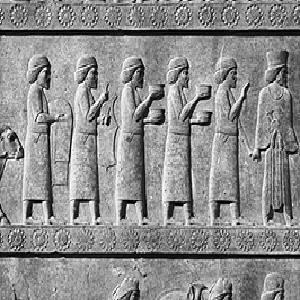Oriental Institute Museum Photographic Archives
As the sponsor and repository of many archaeological expeditions throughout the 20th century, the Oriental Institute has amassed a large collection of artifacts and other materials. The photographic archive details images from ancient sites and the processes by which they were rediscovered in modern times. This excellent website makes some of the images available, providing a taste of the rich holdings.
There are three main subsections. First, there are 66 photographs from expeditions in Egypt, Iran, Iraq, and Sudan. Second, there are 967 images detailing Persepolis and other ancient Iranian sites. Third, there are 1,055 photographs from Dr. James Breasted’s expeditions to Egypt and Sudan conducted from 1905 to 1907. All of the image files are available as low-resolution thumbnails and higher-resolution GIF files. All of the photographs are exhibited on dedicated pages complete with captions detailing the location, the subject, and the date of the image. Links offer information on purchasing photographs.
The 66 photographs of Egypt, Iran, Iraq, and Sudan come from expeditions of archaeological sites from the 1900s through the 1930s. Important sites, such as Luxor, Meroë, Abu Simbel, and Sakkara represent the Nile civilizations exposed, while Tell Asmar, Khorsabad, and Persepolis are documented in the Iraqi and Iranian expeditions. Each page also features a couple of internal links to expand the user’s knowledge, either about the specific exhibition, the region, or activities of the Oriental Institute that relate to the photo in question.
The subsection featuring 967 images from Persepolis and Iran is well curated and is divided into four subsections for easy navigation and organization. The four sections detail, in order: “the architecture, reliefs, and finds of the Palaces at Persepolis; the prehistoric mound of Tall-i-Bakun; Istakhr, the Islamic city mound; and the aerial survey flights conducted between 1935 and 1937.” The first section is organized according to an easy-to-understand map of the Persepolis complex and comes with a brief yet informative introduction. Other sections are introduced by more detailed information, and students can navigate via a thumbnail page of the images or by an index of the captions.
The third subsection, featuring 1,055 images from Breasted’s expeditions to Egypt and Sudan, is also well organized. Students can read an introduction about the expeditions and what they found, and they may search for images via a site map or an index of captions. These images are very useful for exploring the finds of the expeditions and for viewing images from early 20th-century archaeological excavations. Of particular interest may be the images of Abu Simbel in its original location, before it was moved to higher ground to make room for Lake Nassar in the 1960s.
These photographs are invaluable sources for teachers who wish to illustrate lessons about the ancient civilizations of the Middle East or discussions about archeological research. They also provide a sense of what the curators of the site call “the halcyon days of the 1930s, when universities and museums conducted expeditions on a scale now unheard of.” By digitizing and making available to the public 2,120 of the museum’s 100,000 images, this website provides excellent reproductions of priceless images of now-vanished societies and their material cultures. Moreover, the designers of the website have made this an easy-to-navigate location. This makes the website especially easy for students and teachers to explore.
World history teachers will find the images of ancient archaeological sites particularly useful for lessons about the wonders of Near East civilizations. They will also be able to use these images, as well as the curators’ remarks about them, to teach students about the practices of archaeological digs in the “golden age” of the discipline.
